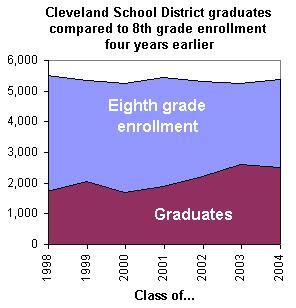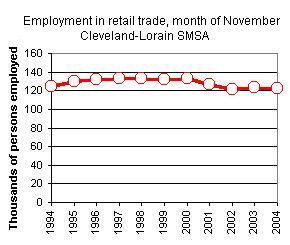Okay, I didn't actually "break" it, since nobody else noticed. The story didn't reach the real media until March 16, after schools CEO Byrd-Bennett made a presentation about it to the School Board. First the PD ran a story. Then a couple of TV stations picked it up. Then the PD ran an editorial expressing a lot of skepticism. Then they ran an op-ed by "school choice" promoter Jay Greene of the conservative Manhattan Institute, who said he was skeptical at first but now realized the District's new numbers were probably legitimate, and the graduation rate had shot up from 28% in 1998 as a result of competition from private charter schools and vouchers. Then the District's former research chief, Peter Robertson, wrote a letter to the editor in which he said:
For years, the Cleveland schools have been explaining that the "real" graduation rate was about 50 percent, not the 28 percent figure Manhattan Institute researcher Jay Greene made up. We explained repeatedly that we had historical dropout reporting problems and that it would take about four years for the official numbers to reflect our corrected reporting... The press never bought the district's explanations and always gave air time to Greene's uninformed disbelief.(Mr. Robertson didn't explain why Byrd-Bennett herself keeps repeating Mr. Greene's "made-up" 28% figure -- for example, in the the District press release linked above -- but let's not complicate this story unduly.)
So, are you confused enough yet?
Well, forget the percentages. There's a much simpler measure of the schools' outcomes -- the actual number of kids who are getting diplomas. And by that measure, it's undeniable that something very hopeful has happened recently.
From the District's Office of External Affairs, here are the numbers of kids who actually graduated over the last seven years:
1,741 in 1998And here are those numbers graphed against the number of kids enrolled in the eighth grade four years earlier (my own dumbed-down version of the graduation rate):
2,050 in 1999
1,700 in 2000
1,881 in 2001
2,205 in 2002
2,614 in 2003
2,508 in 2004

As you can see, the number of eighth graders in each class varied very little, while the number of graduates four years later has changed significantly. From 1998 through 2001 (Byrd-Bennett's first four years on the job) the District graduated an average of only 1,843 seniors. In the past three years, this average has jumped to 2,442... an increase of six hundred graduates annually! (If you just gotta have percentages, that's a 33% improvement.)
Clearly, something important is happening in Cleveland's public high schools, and it's not just improved record-keeping. The Manhattan Institute, inevitably, says it's competition from private schools. The CEO says it's "a conversion to small schools..., targeted assistance for students for the Ohio Graduation Test and proficiency tests, [and] credit-recovery programs (including twilight and extended day programs)". Cool Cleveland says we shouldn't forget "strong leadership provided by schools CEO Barbara Byrd-Bennett, and Mayoral control of the school board which eliminated political posturing."
Who's right? Maybe they all are. Or maybe we're just seeing the sum of a lot of small successes by a lot of different groups and individuals -- mentoring and tutoring, technology programs, entrepreneurship groups, college prep and scholarship programs, etc., etc. Or maybe it's something else entirely -- something in the city's culture or demographics that nobody's recognized yet.
But whoever shares in the credit, something is working -- something that we all need to understand better so we can help keep it going.
A
